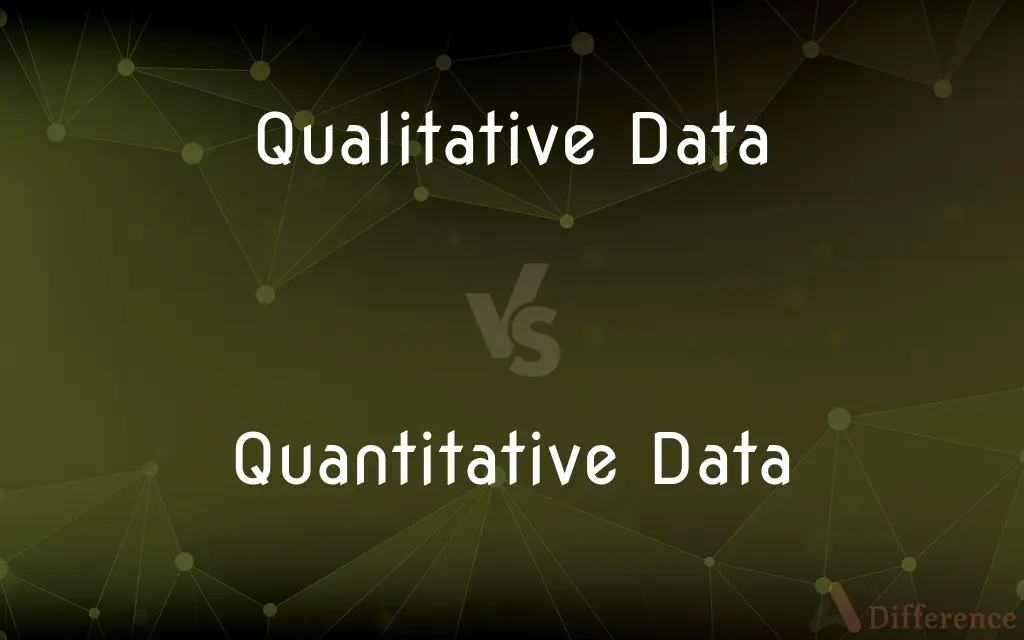Qualitative Data vs. Quantitative Data — What's the Difference?
Edited by Tayyaba Rehman — By Fiza Rafique — Published on December 14, 2023
Qualitative Data describes qualities or characteristics. Quantitative Data is numerical and measures quantity.

Difference Between Qualitative Data and Quantitative Data
Table of Contents
ADVERTISEMENT
Key Differences
Qualitative Data and Quantitative Data are central to research, serving distinct roles in understanding phenomena. Qualitative Data delves into the descriptive aspects of data, capturing the nuances, feelings, and attributes. In contrast, Quantitative Data is all about numbers, allowing for statistical analysis and concrete measurements.
When a researcher gathers Qualitative Data, they're aiming to explore subjective experiences, beliefs, or behaviors. For instance, open-ended survey responses or interviews can yield rich Qualitative Data. On the other hand, Quantitative Data arises from close-ended questions or measurements, resulting in numerical values that can be graphed or statistically tested.
Suppose a company wants to understand customer satisfaction. Qualitative Data could be testimonials detailing specific experiences, while Quantitative Data could be the numerical rating customers give out of 10. Both data types provide valuable insights but in different ways.
Imagine a health study aiming to understand a new medication's effects. Qualitative Data might capture patients' feelings or perceptions about the medication, such as side effects. Simultaneously, Quantitative Data might involve the measured reduction in symptoms or the count of patients who experienced side effects.
In essence, while Qualitative Data dives deep into understanding "how" and "why" through descriptions, Quantitative Data quantifies and measures phenomena, allowing for broader generalizations.
ADVERTISEMENT
Comparison Chart
Nature
Descriptive
Numerical
Type of Information
Qualities or characteristics
Quantity or measurements
Analysis
Thematic or content analysis
Statistical analysis
Example Collection Method
Interviews, focus groups
Surveys with close-ended questions, tests
Result Representation
Words, images
Numbers, charts
Compare with Definitions
Qualitative Data
Information capturing the depth and nuance of a subject.
The open-ended survey responses provided qualitative data about customer preferences.
Quantitative Data
Information represented in numbers or quantities.
The survey yielded quantitative data on the percentage of satisfied customers.
Qualitative Data
Non-numerical data capturing subjective experiences.
The interviews gave qualitative data on employees' job satisfaction levels.
Quantitative Data
Structured data that can be plotted or graphed.
The temperature readings gave quantitative data over a month.
Qualitative Data
Descriptive data that represents phenomena in words or images.
Artists provided qualitative data through paintings depicting the city's culture.
Quantitative Data
Numerical data that can be measured or counted.
The company gathered quantitative data on monthly sales figures.
Qualitative Data
Data derived from human experiences, perceptions, or behaviors.
The testimonials offered qualitative data on the impacts of the new policy.
Quantitative Data
Data that allows for statistical analysis.
The test scores provided quantitative data on student performance.
Qualitative Data
Information that describes qualities or characteristics.
The feedback from users provided rich qualitative data about the app's interface.
Quantitative Data
Measurable data expressing quantity, amount, or range.
The laboratory results offered quantitative data on the chemical concentrations.
Common Curiosities
What defines Quantitative Data?
Quantitative Data is numerical and expresses amount, quantity, or range.
Why is Quantitative Data useful?
Quantitative Data allows for statistical analysis and objective measurements.
Can a study use both Qualitative Data and Quantitative Data?
Yes, many studies use a mixed-methods approach to capture both data types.
When should I use Qualitative Data in research?
Use Qualitative Data when exploring subjective experiences, beliefs, or behaviors.
Are photographs considered Qualitative Data?
Yes, photographs can capture qualities and characteristics, making them Qualitative Data.
Why is Qualitative Data often harder to generalize?
Because Qualitative Data is deeply contextual and subjective, it may not represent broader populations.
Can Quantitative Data be transformed into Qualitative Data?
While you can interpret Quantitative Data qualitatively, the data's numerical nature remains.
Why is Qualitative Data valuable in understanding human behavior?
Qualitative Data captures nuances, feelings, and depth, offering insights into human experiences.
Can I quantify Qualitative Data?
While you can code and categorize Qualitative Data, its descriptive essence remains.
How is Quantitative Data typically visualized?
Quantitative Data is often visualized using charts, graphs, and tables.
What is Qualitative Data in simple terms?
Qualitative Data describes qualities or characteristics without using numbers.
What are common methods to analyze Quantitative Data?
Statistical tests, data visualization, and regression are common for Quantitative Data.
What tools can capture Qualitative Data?
Interviews, focus groups, and open-ended surveys are common tools for Qualitative Data.
Are percentages considered Quantitative Data?
Yes, percentages are numerical and thus fall under Quantitative Data.
How can I ensure the validity of Qualitative Data?
Triangulation, member checking, and peer review can help ensure Qualitative Data's validity.
Share Your Discovery

Previous Comparison
WEB Novel vs. Light Novel
Next Comparison
MLA vs. MPAuthor Spotlight
Written by
Fiza RafiqueFiza Rafique is a skilled content writer at AskDifference.com, where she meticulously refines and enhances written pieces. Drawing from her vast editorial expertise, Fiza ensures clarity, accuracy, and precision in every article. Passionate about language, she continually seeks to elevate the quality of content for readers worldwide.
Edited by
Tayyaba RehmanTayyaba Rehman is a distinguished writer, currently serving as a primary contributor to askdifference.com. As a researcher in semantics and etymology, Tayyaba's passion for the complexity of languages and their distinctions has found a perfect home on the platform. Tayyaba delves into the intricacies of language, distinguishing between commonly confused words and phrases, thereby providing clarity for readers worldwide.














































